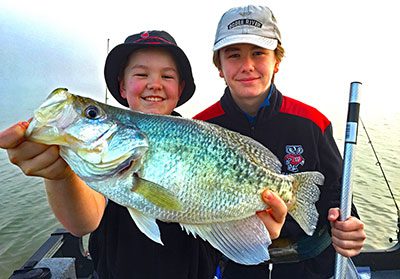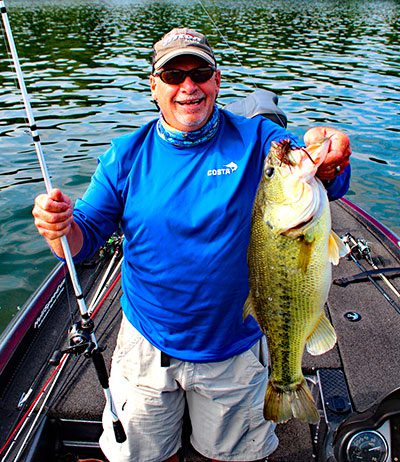
by Capt. Richard Simms
Chattanooga – a river runs through it.
Yes, the Tennessee River slices the city of Chattanooga – also known as the “Scenic City – in half. With TVA’s Chickamauga Dam within the city limits, portions of Chickamauga and Nickajack Reservoirs are within a long cast of Downtown Chattanooga – offering a combination of lake fishing upstream from the dam and riverine conditions downstream.
The varied ecosystem means that almost every warmwater fish species found in the Tennessee River can be caught alongside the popular Tennessee Aquarium or even in the shadow of historic Lookout Mountain. Let’s hit the fishing highlights.
Largemouth Bass
Chickamauga Lake has evolved full circle in the last 40 years. Aquatic vegetation grew in large quantities in the 1970’s creating a reservoir jam-packed with largemouth. Most were small – 5 lbs. or less – but they were plentiful. In the early 90’s, however. a mysterious die-off wiped out the vegetation, resulting in a crash in the largemouth population.

In the year 2000, the Tennessee Wildlife Resources Agency (TWRA) began an experimental stocking program, adding Florida-strain largemouth bass fingerlings annually to Chickamauga. It took ten years to see results – but those results were incredible. The numbers of double-digit bass have been shocking. The most rigorous and fast-growing are the hybrids between the Florida bass and the native, northern largemouth. One of those fish ultimately grew to be a new Tennessee State Record Largemouth, 15.3 lbs. caught by Gabe Keen in February 2015.
In recent years Chickamauga has consistently been ranked among the country’s top largemouth lakes. There are numerous professional anglers who have moved here, making Chickamauga their “home lake.” That list is currently topped by Jacob Wheeler, 3-time MLF “Angler of the Year.” There has also been a proliferation of professional bass fishing guides who now call Chickamauga Lake their home.
Nine years ago, the Florida-bass stocking program was expanded to several other Tennessee lakes, although it is still too soon to tell if those results will mirror the great fishing in Chickamauga.
Blue Catfish
In spite of the number of restaurants that serve them, there was a time when anglers considered catfish a “trash fish.” Those days are done.
Anglers discovered that the Tennessee River is a virtual “catfish factory,” routinely churning out huge blue cats in the 50-pound class and above. The numerous bridge abutments in downtown Chattanooga are just one of many places you might see anglers searching for trophy blues along with tasty channel catfish and occasional flatheads.
Crappie
Chickamauga Lake has gained worldwide fame for its great bass fishing; however, the awesome crappie fishing remains a somewhat well-kept secret. The lake offers white crappie and black crappie in outstanding numbers. Of course, late winter and spring is when most people concentrate on crappie. However, with a wide variety of shallow and deep-water habitat, those who know how can put slabs in the boat year-round.
Shooting docks and trolling crankbaits are the “go-to” summer patterns. But throughout the year you will see anglers using virtually any crappie fishing technique that exists. Personally, I love long-line trolling jigs beginning in late February through late April.
Walleye
I bet many people reading this will be shocked to see walleye on this list. Some may even question it. If so, they have probably never fished the headwaters of Chickamauga Lake (the tailwaters downstream from Watts Bar Dam, about 50 miles north of Chattanooga). While usually considered a “northern” fish, walleye are actually native to Tennessee in select locations. In fact, the world record walleye (25 lbs.) was caught in Tennessee in 1960.
Walleye are first cousins to sauger, which were once plentiful in the Tennessee River. However, sauger went on a mysterious decline. TWRA fisheries biologist Mike Jolley and his peers decided to try stocking walleye to fill the niche left open by sauger. “Walleye live longer than sauger, they get bigger and they are easier to raise in hatcheries,” said Jolley. “We also hope they’ll offer more of a year-round fishing opportunity than sauger overall.”
In 2013 TWRA began stocking walleye fingerlings annually in Chickamauga Lake, downstream of Watts Bar Dam. It didn’t take long to start seeing results, although it took a while for southern anglers to figure out the best techniques for catching this “new-to-us” species. Now, however, the word is out.
Capt. Scott Lillie cut his teeth, as a youngster, trolling for walleye up north. Now Capt. Lillie employs the trolling techniques he learned decades ago to fill live wells with walleye for his clients. His available winter guide trips routinely book up a year in advance.
Those are the kind of reports that make Jolley proud. “It’s everything we hoped it would be and probably more,” said Jolley.
Everything Else
Those are some of the fishing highlights to be found in Southeast Tennessee. Of course we haven’t mentioned smallmouth bass, spotted bass, striped bass (rockfish), white bass, bluegill or shellcrackers. All offer outstanding fishing just out Chattanooga’s backdoor.
For the trout purists, a few local streams are stocked. However just about an hour’s drive to the east, the Hiwassee River provides remote, mountain trout fishing that rivals what you see in the classic movie, A River Runs Through It.
Regardless of what species you prefer to “target,” Chattanooga is the perfect place to take aim.